|
Saturday, April 22 Beijing Our tour today took us
to the Great Wall at Badaling and Ming Tombs. The earliest sections of
the nearly 4000-mile long wall were constructed over a period of two
centuries beginning about 403 BC. In 221 BC, China’s first emperor,
Qin Shi Huangdi, put some 300,000 men to work to connect up many of the
smaller sections to protect the nation from invaders.
Norma had stopped climbing at about the 2nd tower and said she would head back down. I never saw her on my way back and figured she would be at the restaurant just below the Great Wall entrance where a buffet lunch had been scheduled for us. However, she wasn’t there when I returned and everyone else was already eating. After a while I figured she wasn’t in the restroom and decided I had better go look for her, wondering how I would spot her in the crowds. Fortunately, she walked in the door at about the time I was about to leave. She said she had gotten turned around and wasn’t sure where the restaurant was.
Dinner was on our own and since we were pretty tired we decided to eat in the Renaissance Restaurant in the hotel. We split a lamb chop dinner, but my first bite of lamb got lodged in my esophagus. Fortunately, it didn’t block my windpipe but I couldn’t eat or drink. At least I figured the dinner wouldn't go to waste since Norma could have my portion too. But later she said the lamb was tough and wasn't any good anyway. In the meantime, I tried to relax hoping that the cramp in my esophagus would let up. About 11 p.m. we asked our tour director, James Jin what we should do. We were quite surprised when he said his girl friend was a doctor, so he called her. She suggested I induce vomiting to dislodge the meat. So using the handle of a toothbrush as a gag, I tried that several times but to no avail. If only the toothbrush handle were longer, I might have used that to push it through. Next she suggested swallowing oil and vinegar, oil for lubrication and vinegar to digest the meat. We had room service bring up a couple of small bowls and I mixed them together and took a swig. It but it wouldn’t go down. It just left me with a terrible taste in my mouth and throat. I couldn’t even swallow my own saliva. My esophagus was like a plugged drain, it would quickly fill up to my windpipe at which time I’d have to retch to clear it out. So about midnight we got a taxi and went to the emergency room at the Peking Union Medical College Hospital. They took an x-ray and EKG, neither of which showed anything. They said they couldn’t do anything more until Monday morning when an MD would be there. Since it wasn’t life-threatening, we headed back to the hotel, but on the way, James decided to go to a second hospital. After another hour there, they couldn’t help either, so we went back to the hotel. James left us about 2:45 a.m. and suggested I travel to Shanghai with the group the next day and go to the hospital there. It was impossible for me to lie down because I would immediately begin choking. So I tried to sleep sitting upright in bed with pillows -- a very rough night and I had to keep spitting out my saliva. It’s amazing how much saliva we produce. I did get a couple of catnaps though because saliva production seems to cease when you sleep. Sunday, April 23. Beijing I was sure I'd be OK by
Sunday morning but alas, my esophagus was still obstructed. I was
getting a bit dry by then but no water or breakfast for me. While Norma
had breakfast, I packed the suitcases. Since the bus would go directly
to the airport after the morning tour, I rode along spitting in a paper
cup or plastic bag. After dropping everyone at the hotel, we checked into our hotel room and then James, Norma and I took a taxi to the Huashan Worldwide Medical Center -- a first-class hospital. What a relief -- this hospital looked as nice as any I've seen in the US. The hospitals in Beijing are another story. The first hospital was about what I expected in China, second rate and certainly not up to our standards. James said this was the best hospital in Beijing. The emergency room in the second hospital was so bad I was hoping they wouldn't keep me there. The floors were dirty, a gurney soiled in blood was parked in the waiting room, and the restroom was filthier than the worst service station restroom I've ever encountered. The waiting room chairs were sitting under the x-ray viewing screens so every time a doctor or technician viewed an x-ray you had to move or he would lean over the top of you to see the film. A number of sick and injured people were waiting or milling around and a couple more were lying on gurneys. I'm sure this was a last-resort hospital for those who can't afford medical help. So if you ever get sick in China, wait until you can get to Shanghai. After a quick exam of my throat, they checked me in to a room with two beds on the seventh floor. Norma and James left to get dinner and then went to see the scheduled acrobatic show. I was hooked up to an IV and given fluids, antibiotics, etc. I was much more comfortable in the adjustable hospital bed than the hotel bed the night before. Sometime that evening, maybe a couple of hours later, the nurse checked my blood pressure. It was very high 200/110, I think. After double-checking it, she gave me a small pill to place under my tongue. This brought my blood pressure back down to normal. About 11 p.m. the
obstruction finally cleared and I was relieved. I was looking forward to
a good nights sleep, but then I got a headache. Probably a
caffeine-withdrawal headache since I hadn't had anything to drink in 30
hours. I kept asking the nurses for a pill, but they just kept saying
they would ask the doctor. I never got anything except more blood
pressure measurements -- another restless, uncomfortable night. When the doctor came in about 8 a.m. he said he would get me something. But then the nurse suggested I eat breakfast first. So it was about 9 a.m. before I got a pill for my headache. An hour later, I felt great and I checked out of the hospital at 10:20 a.m. The nurse called a taxi, but when I showed the driver my key card with the English name of my hotel, he had no idea where it was. The doorman and a couple of other people came over to help but no one recognized the hotel name. Finally, the nurse had to come down to the street from the 7th floor and explain how to get there. Traffic was bad and it took an hour just to get a couple of miles. I was concerned that James or Norma would be coming to the hospital while I was leaving so I had the nurse call James’ cell phone number to tell him I was checking out, but he didn't answer because it was very noisy where he was. When he returned the call later, he got a FAX machine so he never got the message. After getting back to the hotel, Norma was just getting up. So we went to the hotel café to split a ham and cheese sandwich and I had a cup of curry soup – not bad – considering I don’t like curry. I guess anything would taste good after my two-day fast. Some good came of this however, I lost about 4 pounds. Some people have their stomach stapled to lose weight; well if you are really serious about losing weight, nothing is as effective as a plugged esophagus. Both of us missed the day’s activities which included visits to the Shanghai museum, a carpet factory, and the famous Bund. We also missed out on the traditional Mongolian barbecue lunch.
|
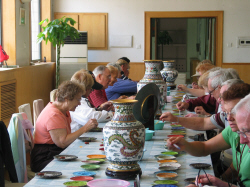 However, the most impressive sections seen today were built during the
Ming Dynasty (1368-1644 A.D.). The wall’s construction varies from
brick and mortar to earthen ramparts. The most accessible section of the
wall, which actually was built around 1345, is about 35 miles northwest
of Beijing in the Badaling Hills. Our first bus stop, however, was at a
cloisonné (enamelware) factory where we watched artisans creating
brilliantly colored vases and other enamelware using strips of metal and
traditional painting techniques to produce beautiful and complex
patterns. Each of us were given time to try our hand at the delicate
painting.
However, the most impressive sections seen today were built during the
Ming Dynasty (1368-1644 A.D.). The wall’s construction varies from
brick and mortar to earthen ramparts. The most accessible section of the
wall, which actually was built around 1345, is about 35 miles northwest
of Beijing in the Badaling Hills. Our first bus stop, however, was at a
cloisonné (enamelware) factory where we watched artisans creating
brilliantly colored vases and other enamelware using strips of metal and
traditional painting techniques to produce beautiful and complex
patterns. Each of us were given time to try our hand at the delicate
painting. At
Badaling, we climbed the wall along with hundreds of other tourists.
Despite the fact that the walkway is about 15 feet wide, the foot
traffic was so heavy in places, you had to push yourself through the
crowds. Massive stone lookout towers stand at strategic intervals along
the wall at a distance of two bowshots apart. With this spacing, archers
stationed in the towers, could protect the entire wall. The wall
winds its way over incredibly steep hills and ridges. It is mind
boggling to envision the difficulty and back breaking work to build just
the few miles of this incredible wall that we were seeing, yet alone
4000 miles.
At
Badaling, we climbed the wall along with hundreds of other tourists.
Despite the fact that the walkway is about 15 feet wide, the foot
traffic was so heavy in places, you had to push yourself through the
crowds. Massive stone lookout towers stand at strategic intervals along
the wall at a distance of two bowshots apart. With this spacing, archers
stationed in the towers, could protect the entire wall. The wall
winds its way over incredibly steep hills and ridges. It is mind
boggling to envision the difficulty and back breaking work to build just
the few miles of this incredible wall that we were seeing, yet alone
4000 miles. 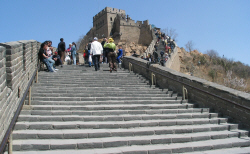 I
climbed past the third tower where vendors were selling souvenirs and
someone with a camel was providing a photo op to those who wanted their
picture taken riding the camel. Just beyond and below the third tower
was a narrow gauge railroad providing an easy way to reach this part of
the wall. I continued on to about halfway to the fourth tower when I
realized I had to head back to meet our time schedule. The views from
this vantage point are quite spectacular but perhaps not nearly as
impressive as they would be when the landscape is green. Spring had not
yet sprung in this area and the mountains were grey-brown and very dry.
I
climbed past the third tower where vendors were selling souvenirs and
someone with a camel was providing a photo op to those who wanted their
picture taken riding the camel. Just beyond and below the third tower
was a narrow gauge railroad providing an easy way to reach this part of
the wall. I continued on to about halfway to the fourth tower when I
realized I had to head back to meet our time schedule. The views from
this vantage point are quite spectacular but perhaps not nearly as
impressive as they would be when the landscape is green. Spring had not
yet sprung in this area and the mountains were grey-brown and very dry.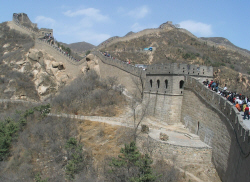 On
the way up, one 84-year-old member of our group, Kitty Knoche, asked me
to take her picture on the wall. She would stop to rest now and then but
was putting a lot of younger people to shame. She asked me to watch for
her on my way down. When I started back I figured she would be long
gone, but lo and behold, here she was about halfway between the 2nd
and 3rd tower. I asked her how far she had gone and she said,
"Well, up to the 3rd tower where I got to ride a
camel". Throughout our trip she continued to amaze everyone with
her stamina even later when the ship doc said she had pneumonia. She was
a little unsteady on some of the steep steps so I accompanied her the
rest of the way down. By the time we got back, our tour guide was
getting a little worried about her -- but she was fine.
On
the way up, one 84-year-old member of our group, Kitty Knoche, asked me
to take her picture on the wall. She would stop to rest now and then but
was putting a lot of younger people to shame. She asked me to watch for
her on my way down. When I started back I figured she would be long
gone, but lo and behold, here she was about halfway between the 2nd
and 3rd tower. I asked her how far she had gone and she said,
"Well, up to the 3rd tower where I got to ride a
camel". Throughout our trip she continued to amaze everyone with
her stamina even later when the ship doc said she had pneumonia. She was
a little unsteady on some of the steep steps so I accompanied her the
rest of the way down. By the time we got back, our tour guide was
getting a little worried about her -- but she was fine. In
the afternoon we visited the Ming Tombs and then walked along the Sacred
Way. Thirteen of the 16 Ming emperors are buried in this area. Guarding
the southern entrance are statues of 12 human figures and 12 pairs of
animals placed at intervals along the Sacred Way.
In
the afternoon we visited the Ming Tombs and then walked along the Sacred
Way. Thirteen of the 16 Ming emperors are buried in this area. Guarding
the southern entrance are statues of 12 human figures and 12 pairs of
animals placed at intervals along the Sacred Way.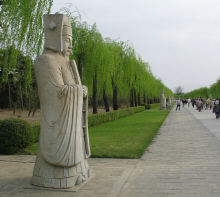
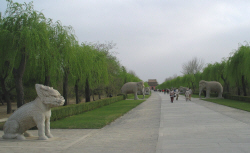
 I
took a nap after lunch so I would be rested up enough to go on the
Shanghai Night Tour. This tour by boat on the river was fantastic with
all the buildings and sky scrapers lit up in bright and changing colors.
The sides of some of the buildings are literally giant screens with
colorful flashing images and advertising.
I
took a nap after lunch so I would be rested up enough to go on the
Shanghai Night Tour. This tour by boat on the river was fantastic with
all the buildings and sky scrapers lit up in bright and changing colors.
The sides of some of the buildings are literally giant screens with
colorful flashing images and advertising.